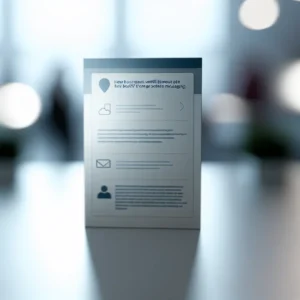Are you struggling to engage your customers effectively? The landscape of business communication has evolved, and leveraging the right tools can make all the difference. Many companies miss out on opportunities due to the limitations of traditional communication methods. You need to meet your customers where they are, and that’s precisely where WhatsApp comes into play.
WhatsApp now serves over two billion users worldwide, making it critical for businesses targeting meaningful interactions. Yet, as your organization grows, so do your communication needs. The WhatsApp API addresses these complex demands, facilitating not only engagement but also operational efficiency.
This article will guide you through the differences between WhatsApp and its API, helping you choose the right solution for scalable success. You’ll also discover how businesses can harness these tools for effective customer communication.
Understanding WhatsApp: Features and Capabilities
WhatsApp, a leading messaging platform, offers an intuitive interface that enables businesses to communicate directly with customers. You can use text, voice, or video messages for immediate responses. For example, a local cafe, Café Conectado, increased its customer satisfaction rating by 30% through timely WhatsApp interactions addressing menu inquiries. Regular updates to the app ensure businesses can leverage new functionalities.
In contrast, the WhatsApp API expands these capabilities, introducing automation and integration. This tool is ideal for larger enterprises needing to manage multiple interactions simultaneously. For instance, a retail giant, MegaShop, automated responses via the API, resulting in a 25% reduction in response time to customer inquiries.
The WhatsApp API integrates seamlessly with Customer Relationship Management (CRM) systems, allowing businesses to track customer behaviors. For example, a financial service company, FinTech Solutions, improved its marketing efforts significantly by sending targeted advice based on past customer transactions, leading to a 20% increase in campaign effectiveness.
Scalability is another advantage. Regular WhatsApp accounts limit you to one-on-one chats, whereas the API facilitates numerous representatives managing inquiries at once. A telecommunications provider, Telco Max, reported an impressive 40% boost in customer service efficiency after implementing the WhatsApp API alongside their support team.
Security is a priority for WhatsApp, providing end-to-end encryption for all messages. The WhatsApp API adheres to these standards, making it a trusted choice for businesses handling sensitive data. This commitment fosters trust—essential for ongoing customer loyalty.
What is WhatsApp API? An Overview
The WhatsApp API is a robust application programming interface that enables sizable businesses to communicate with their customers effectively. Unlike the standard WhatsApp app designed for casual messaging, the API supports complex functions that integrate with corporate systems, enhancing how you connect with customers.
One of the API’s core features is the ability to automate messaging. Businesses can establish automated responses for common questions, ensuring timely and efficient customer service. For example, a tourism company, TravelSmart, implemented automated trip inquiry responses, reducing operational costs by 15% while improving overall response rates.
The flexibility of the WhatsApp API allows for deep integration with CRM systems, marketing platforms, and other essential tools. Unlike standard WhatsApp, which caters to basic messaging needs, this integration provides organizations with advanced features tailored for enhanced customer interactions.
Use cases are versatile, from customer support to promotional campaigns. A local gym, Fitness Hub, utilized the API for sending appointment reminders and special training offers, increasing member engagement rates by 22%. This level of interaction fosters loyalty and drives sales growth.
In summary, WhatsApp API signifies a considerable evolution in how businesses approach communication. The advantages of automation, integration, and personalized experiences set it apart from traditional WhatsApp usage, allowing business owners to maximize customer engagement.
WhatsApp vs WhatsApp API: Key Differences
The primary distinction between WhatsApp and WhatsApp API focuses on usage and scope. WhatsApp facilitates personal interactions, while the API targets businesses seeking to enhance customer communications. The API empowers companies to streamline messaging operations, handle larger volumes of inquiries, and maintain a professional image.
WhatsApp allows basic messaging, including texts and voice messages. On the contrary, WhatsApp API supports advanced functionalities like chatbots and customer interaction tracking, making it particularly appealing for organizations looking to optimize their communication strategies.
The platforms’ use cases differ significantly. WhatsApp is effectively for casual chats among friends; however, the WhatsApp API excels in customer support, marketing campaigns, and transactional messaging. A nonprofit, Charity Connect, successfully utilized the API to handle donation inquiries, boosting donor participation by 35%.
Accessibility also varies between the two. Setting up a personal WhatsApp account is straightforward; businesses, however, must navigate a complex setup for the API, requiring approval and system integration. While this process may seem daunting to smaller enterprises, the returns for larger organizations can be game-changing.
Pricing structures represent another critical distinction. WhatsApp is free, yet costs arise with the WhatsApp API based on message volume and additional features. Businesses must evaluate these expenses against improved customer engagement and conversion rates. A logistics firm, QuickShip, saw a remarkable 50% increase in inquiry conversion after implementing the API, justifying the costs associated.
Use Cases for WhatsApp: When to Use It
Deciding between WhatsApp and its API involves understanding specific use cases each serves. WhatsApp excels for small businesses or individual entrepreneurs needing informal customer connections. For instance, a local artisan bakery might rely on WhatsApp for quick customer orders and inquiries, establishing relationships and improving local reach.
In contrast, the WhatsApp API suits larger organizations with high-volume interactions. This tool integrates WhatsApp functionality within existing systems like CRM, enabling automated responses and efficient tracking. An online retailer, ShopSmart, used the API to manage order notifications, driving up customer satisfaction by 30% as updates arrived via familiar messaging.
Additionally, the WhatsApp API can facilitate multi-agent support easing high inquiry volumes through simultaneous management. A financial services firm, SafeWealth, benefitted from this when handling customer portfolio inquiries, which significantly improved response times and customer retention.
Analytics capabilities further differentiate the two. While WhatsApp provides fundamental communication, the API offers advanced analytics solutions for tracking interactions. Businesses can optimize strategies based on data insights. A tech support provider, TechAid, noted a 25% reduction in ticket resolution time after employing analytical tools through the API.
In summary, your choice between WhatsApp and WhatsApp API hinges on your operational scale and engagement needs. For informal communication, WhatsApp fits the bill, but larger enterprises seeking robust interaction should utilize the API for its advanced features and scalability.
When to Choose WhatsApp API: Advantages for Businesses
Understanding the nuances between WhatsApp and its API guides businesses towards enhanced communication strategies. The WhatsApp Business app is well-suited for smaller operations requiring straightforward customer engagement. However, the API emerges as the better option for those needing scalability and automation.
One key advantage of the WhatsApp API is its capability for bulk messaging. This is invaluable during marketing campaigns, enabling businesses to efficiently keep customers updated. For example, a cosmetics brand, Glamour Co., employed bulk messaging during product launches, resulting in a 40% uptick in pre-sale engagement.
Furthermore, customer interaction automation through chatbots transforms how businesses manage inquiries. A fast-casual restaurant chain, Healthy Eats, reported a 50% drop in customer wait times by implementing chatbots via the API, effectively enhancing overall satisfaction.
Analytics are essential for refining communication strategies. The API provides in-depth insights on message delivery and customer engagement metrics. A fashion retailer, TrendyWear, improved its marketing strategy, leading to a 35% increase in sales after thoroughly analyzing customer interaction data.
Integration capabilities are another critical feature. The API connects effortlessly to existing systems, creating a centralized communication hub. A logistics company, FastTrack, streamlined operations significantly and reported a 45% improvement in team efficiency post-integration with their CRM.
In conclusion, adopting WhatsApp API is a strategic advantage for businesses looking to scale effectively. Its capabilities surrounding automation, analytics, and integration surpass those of the standard WhatsApp Business app, empowering organizations to improve operational efficiency and customer experience.
Integration Scenarios: Combining WhatsApp and WhatsApp API
Incorporating both WhatsApp and WhatsApp API into your communication strategies allows for maximizing benefits across different operational needs. For instance, using WhatsApp for initial customer inquiries can pave the way for seamless integration with the API to handle larger interactions.
Businesses can perform initial interactions via WhatsApp to secure details and then swiftly transition to the API for full-scale customer engagement. A real estate agency, HomeFinder, used this method to respond to property inquiries initially via WhatsApp and switch to the API for detailed follow-ups, which enhanced customer interactions.
Feature differentiation plays a vital role in communication effectiveness. Businesses leveraging the API can take advantage of proactive engagement methods, sending automated appointment reminders and alerts. A health clinic, MediCare, experienced a 20% reduction in missed appointments through proactive notifications provided by the API.
Diverse sector use cases illustrate the API’s potential. An airline, SkyTravel, improved customer service by providing real-time flight updates via the WhatsApp API, enriching the travel experience for their passengers. This approach showcases how integrating the WhatsApp API can elevate organizational efficiency.
Organizations might start with basic WhatsApp communications before advancing to the API. This phased approach minimizes disruptions and aligns with growth strategies—ensuring that businesses scale their capabilities while maintaining exceptional customer service.
Ultimately, determining when to use WhatsApp versus WhatsApp API relies on business size and engagement strategies. While small operations benefit from WhatsApp, organizations poised for growth must harness the API for its extensive features and efficiencies. For further information on effective integration, refer to the official WhatsApp Business API documentation.
Conclusion: Choosing the Right WhatsApp Solution for Your Business
Choosing between WhatsApp and WhatsApp API greatly influences your business operations. Each offers unique benefits tailored to distinct business needs. Understanding these differences is essential for owners, marketers, and IT professionals aiming to enhance interactions and streamline workflows.
WhatsApp excels at facilitating direct, informal communication, making it a suitable choice for small to medium enterprises. Its simple interface enables prompt customer engagement, paving the way for solid relationships. A local repair shop, FixIt Fast, leveraged WhatsApp to connect directly with clients, seeing a 30% increase in repeat business.
Meanwhile, for larger organizations or those with complex communication demands, the WhatsApp API provides critical tools for automation, CRM integration, and high-volume message management. This capacity is essential for businesses focused on structured customer interaction, exemplified by an online grocery service, QuickGrocer, that scaled rapidly after embracing the API.
The advanced features of WhatsApp API empower personalized and segmented communication strategies, driving customer satisfaction. Though WhatsApp supports informal dialogue, it lacks the automation tools that businesses increasingly rely on for efficiency.
Ultimately, your decision between WhatsApp and WhatsApp API should align with specific goals. For personalized interactions, WhatsApp is effective; for scalable operations and advanced features, the WhatsApp API is key. By understanding these distinctions, you can choose the right communication tool that propels your business forward.
For more insights into the advantages of the WhatsApp API, visit Nexloo’s official page. Making an informed choice ensures your business enhances communication capabilities, driving engagement and customer satisfaction to new levels.









